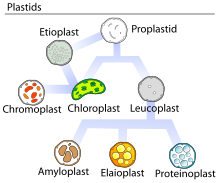Proteinoplast

Proteinoplasts (sometimes called proteoplasts, aleuroplasts, and aleuronaplasts) are specialized organelles found only in plant cells. Proteinoplasts belong to a broad category of organelles known as plastids. Because they lack pigment, proteinoplasts are more specifically a kind of leucoplast. They contain crystalline bodies of protein and can be the sites of enzyme activity involving those proteins. Proteinoplasts are found in many seeds, such as brazil nuts, peanuts and pulses. Although all plastids contain high concentrations of protein, proteinoplasts were identified in the 1960s and 1970s as having large protein inclusions that are visible with both light microscopes and electron microscopes.
A book written in 2007 noted that no scientific research had been published in the previous 25 years on proteinoplasts.[1]
See also
References
- ^ Wise, Robert (2007). "1". The Diversity of Plastid Form and Function (PDF). Springer.
